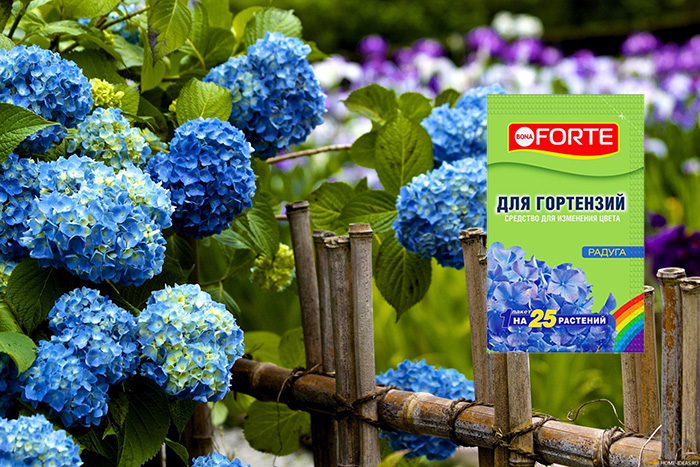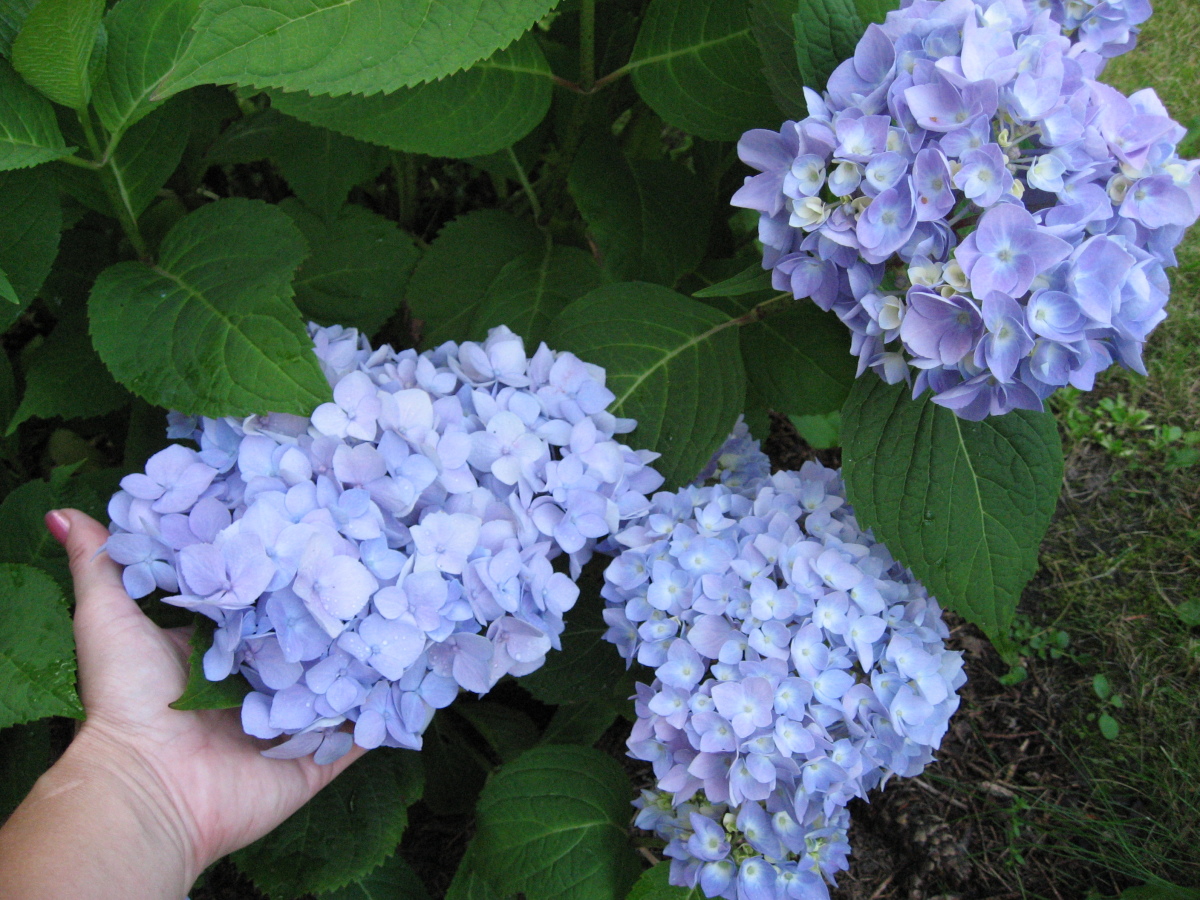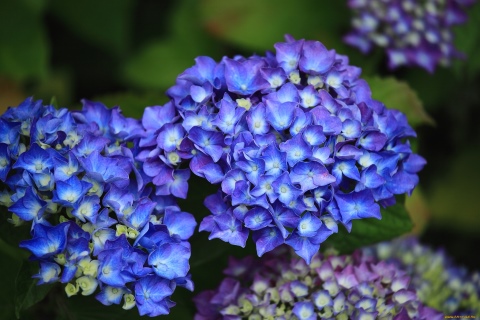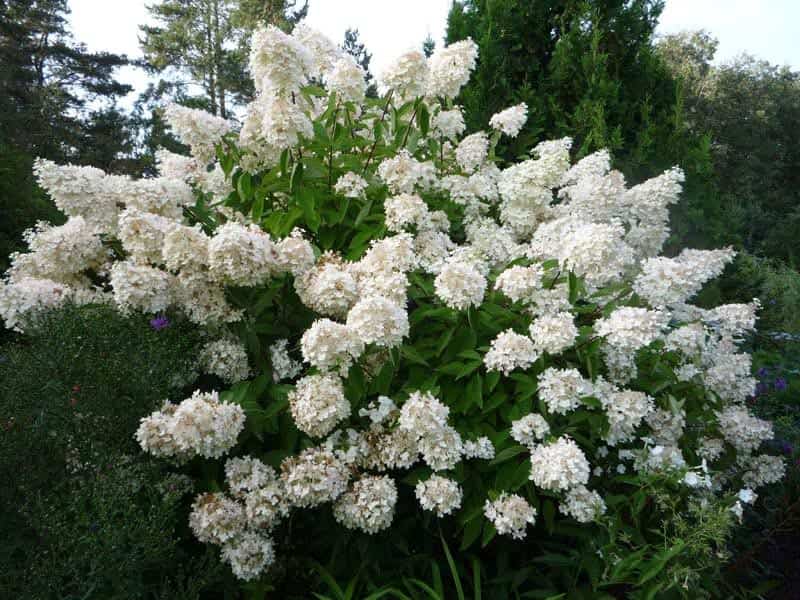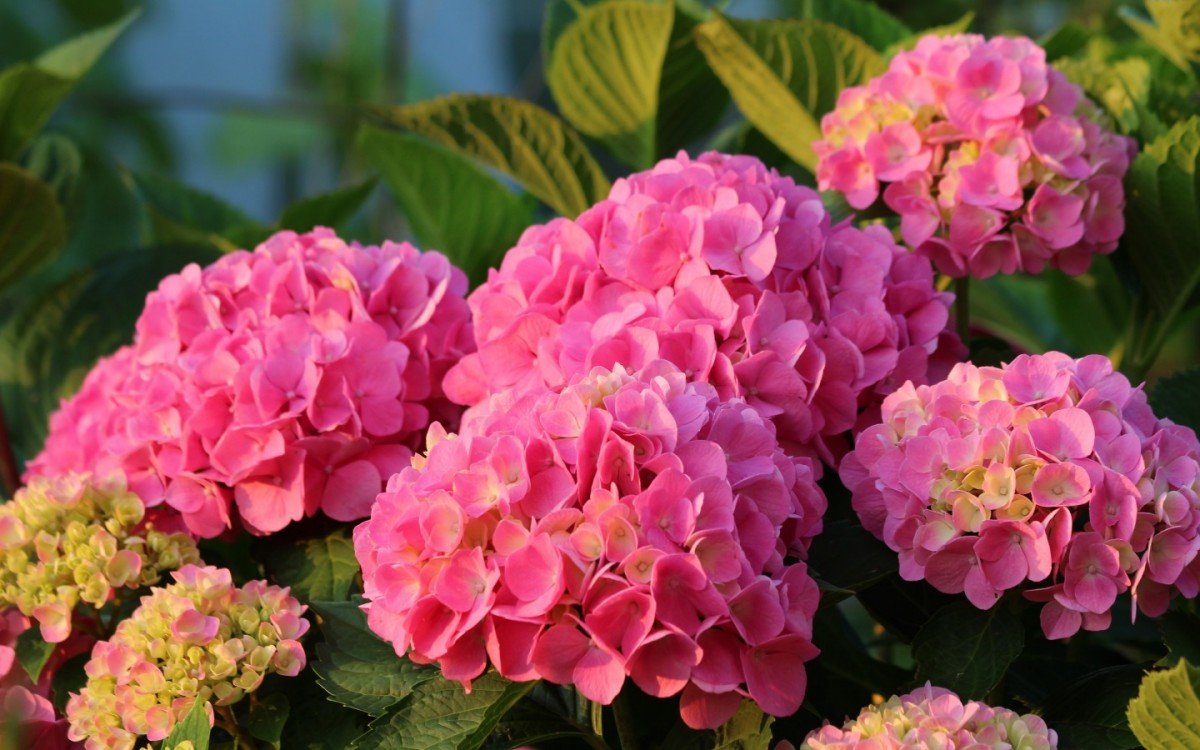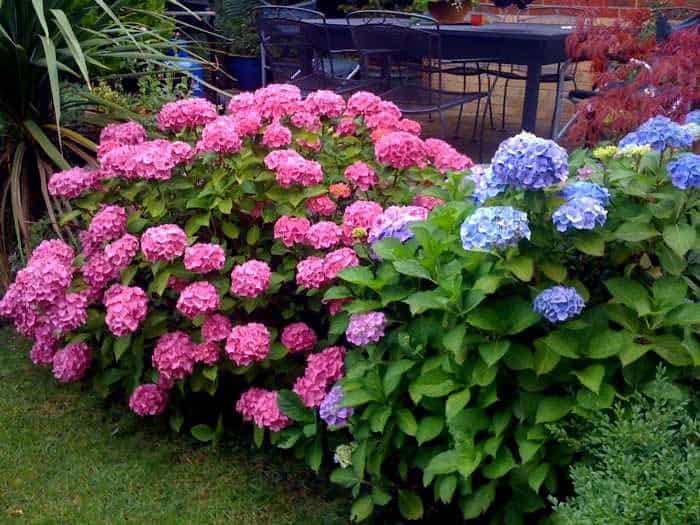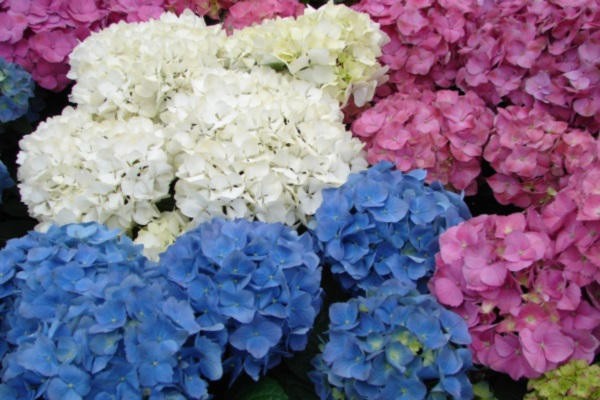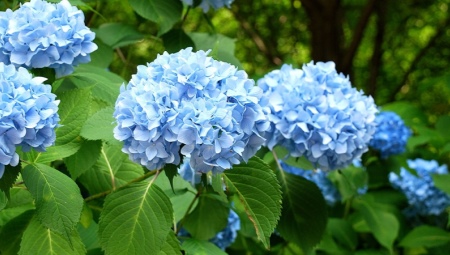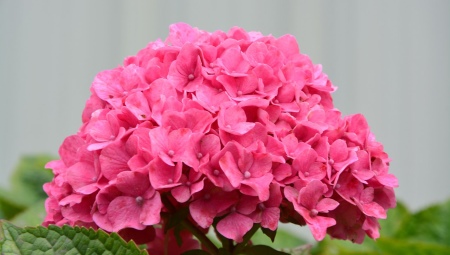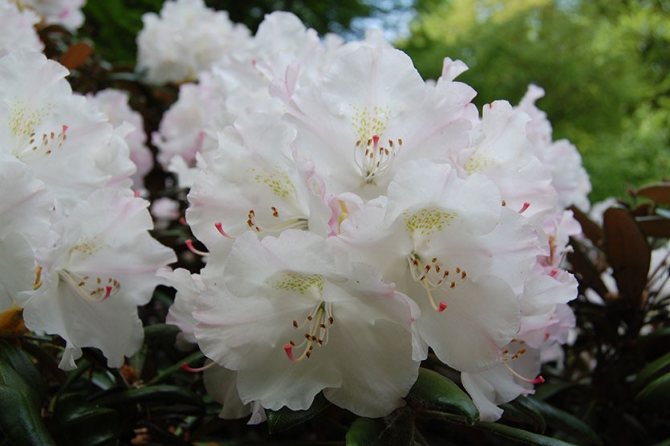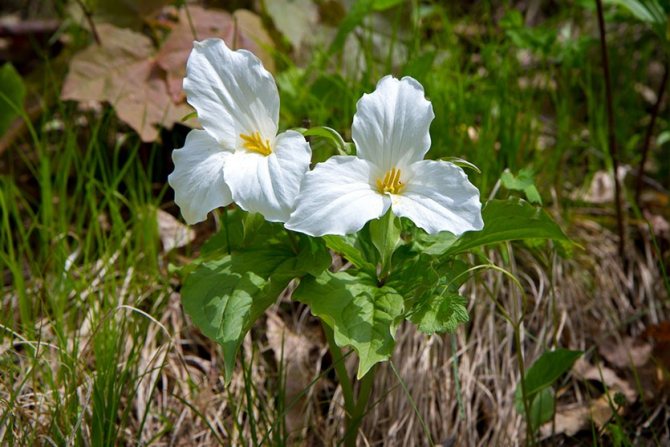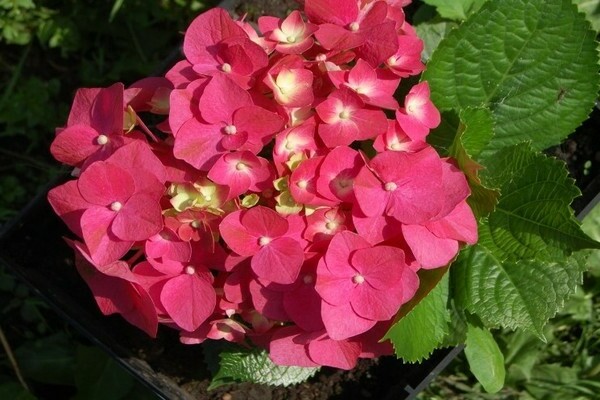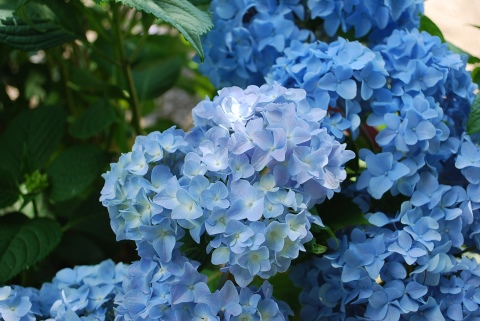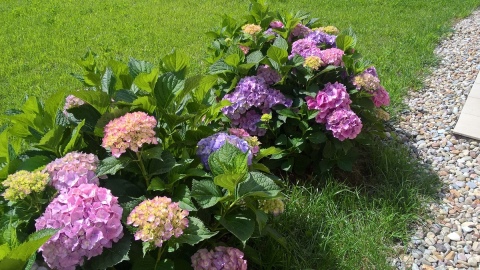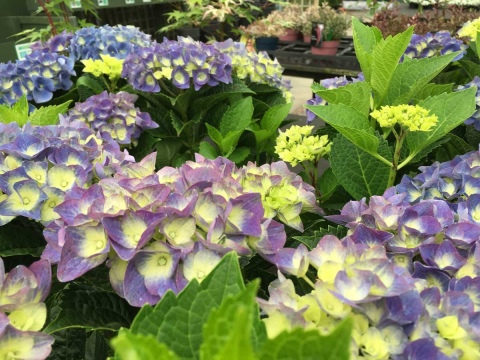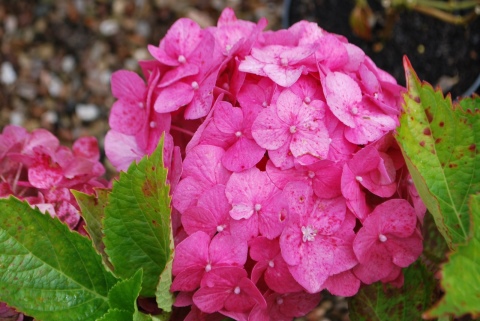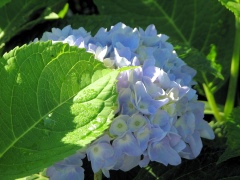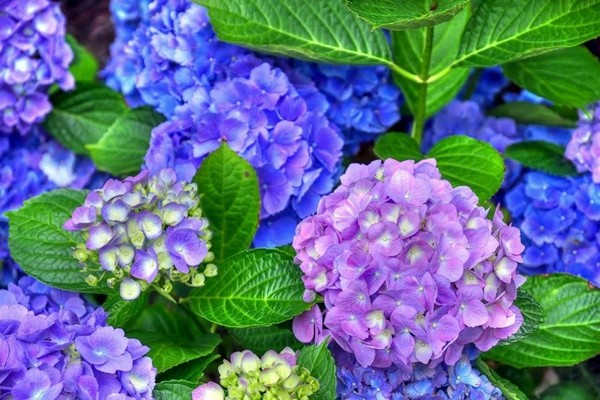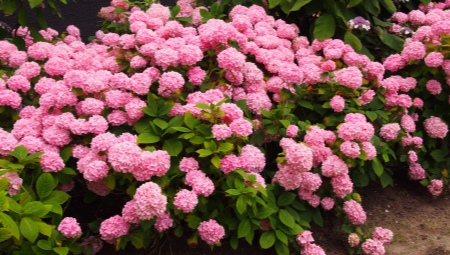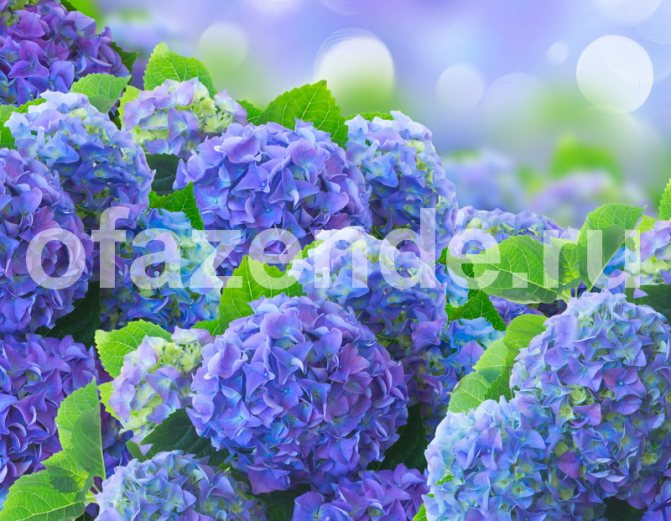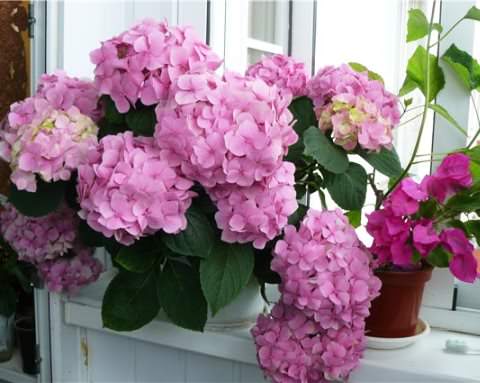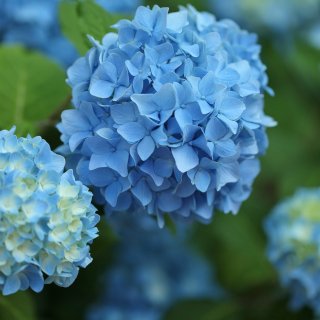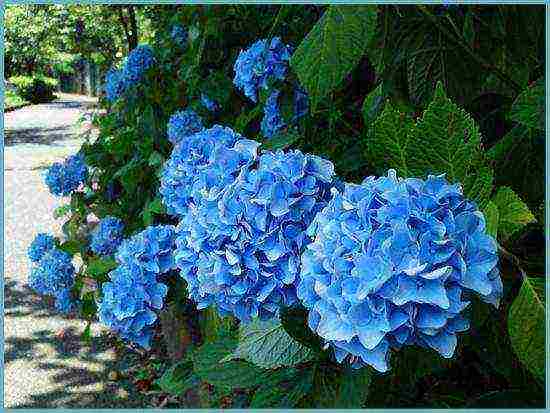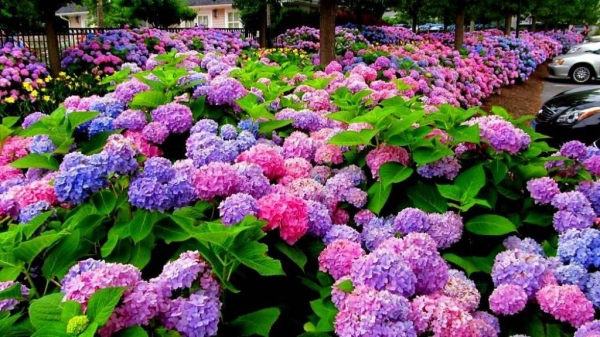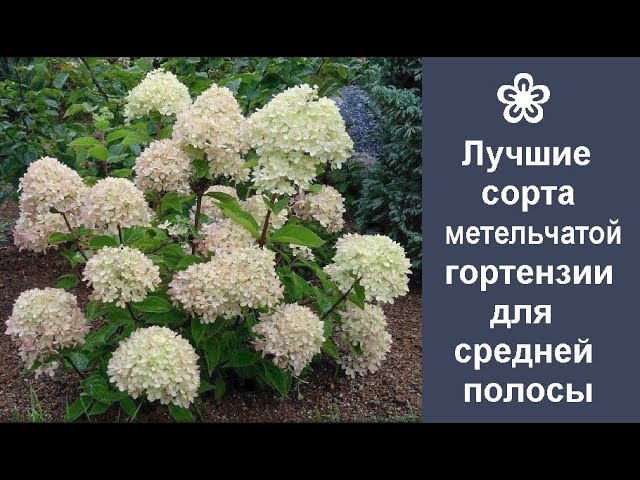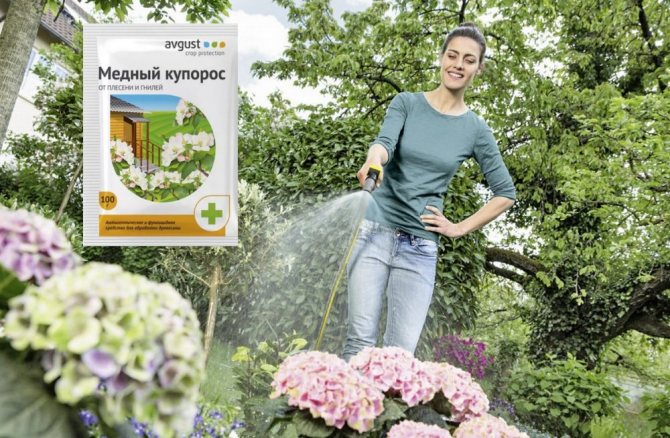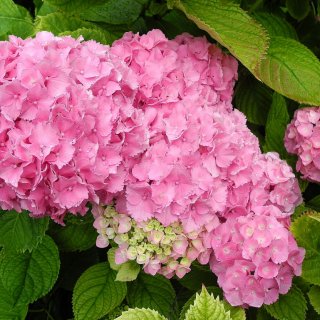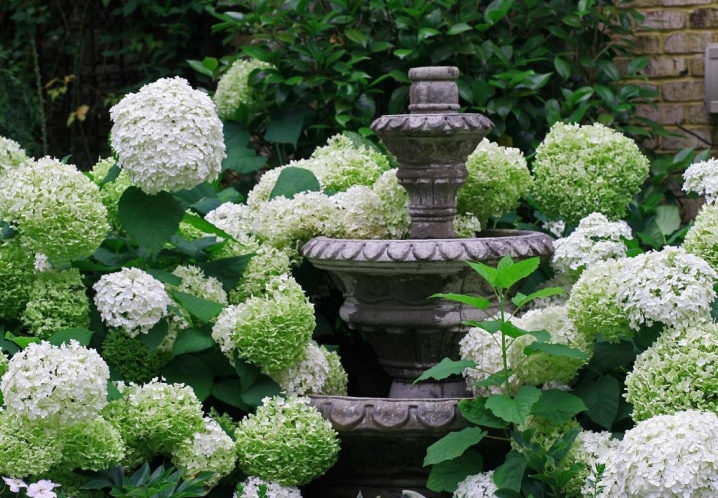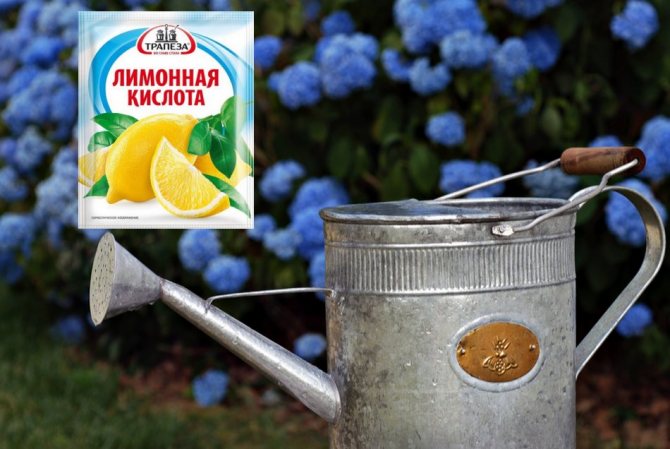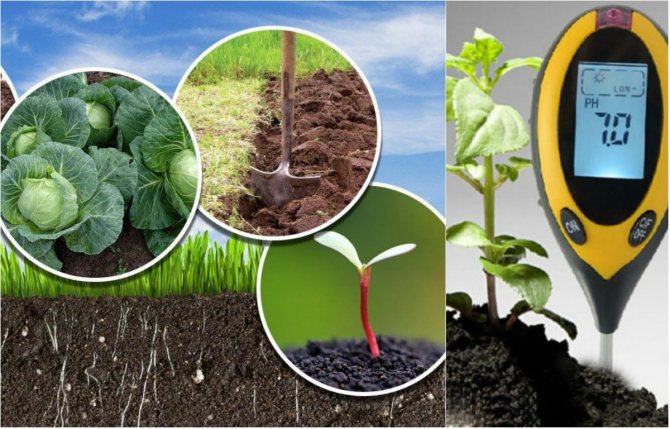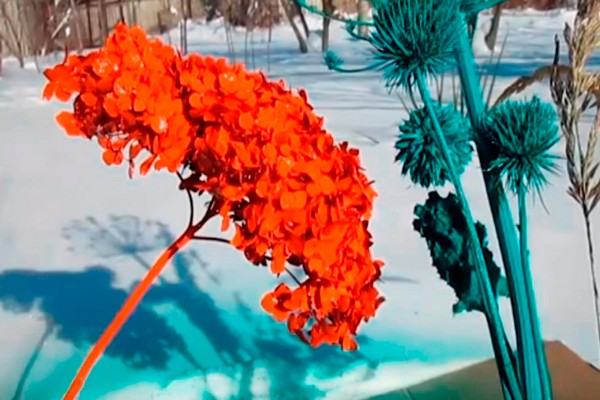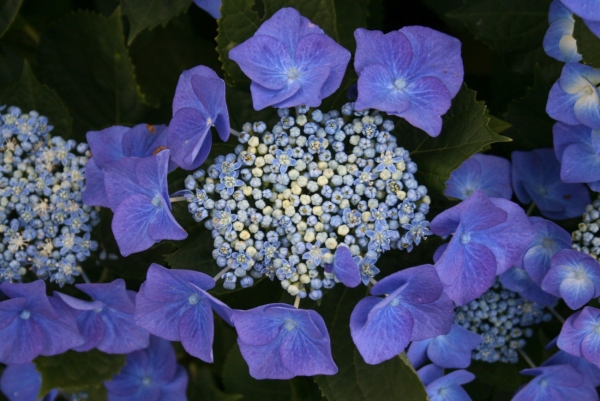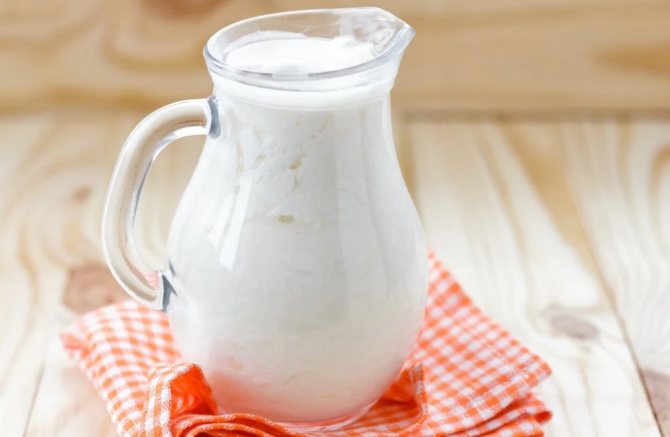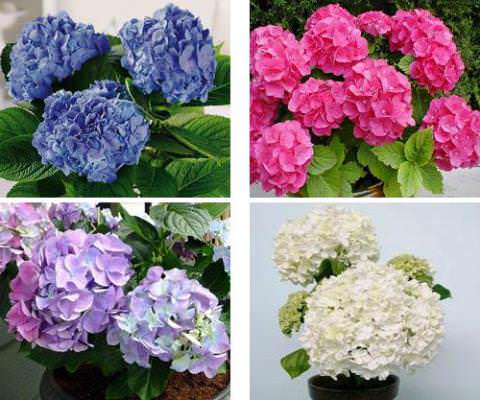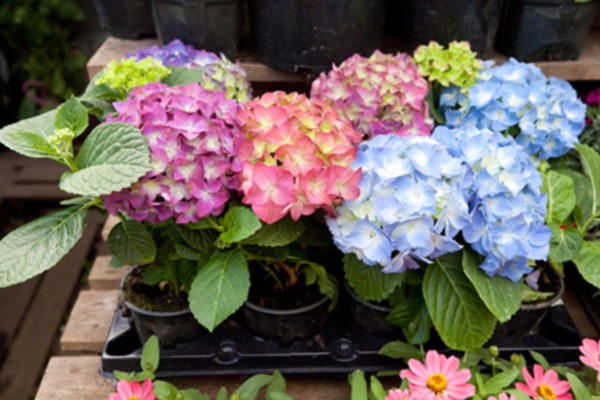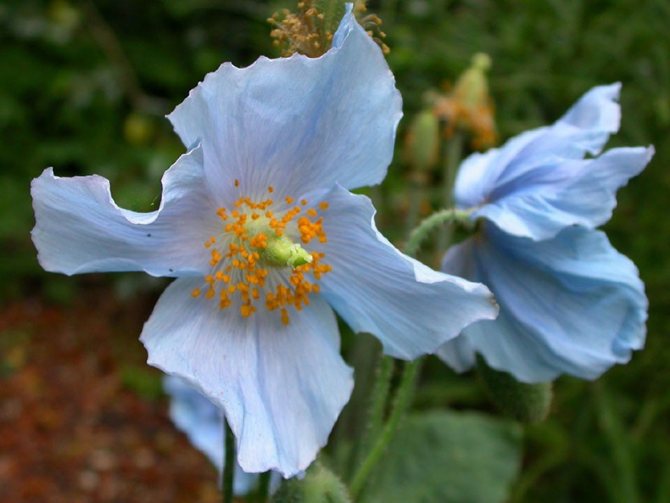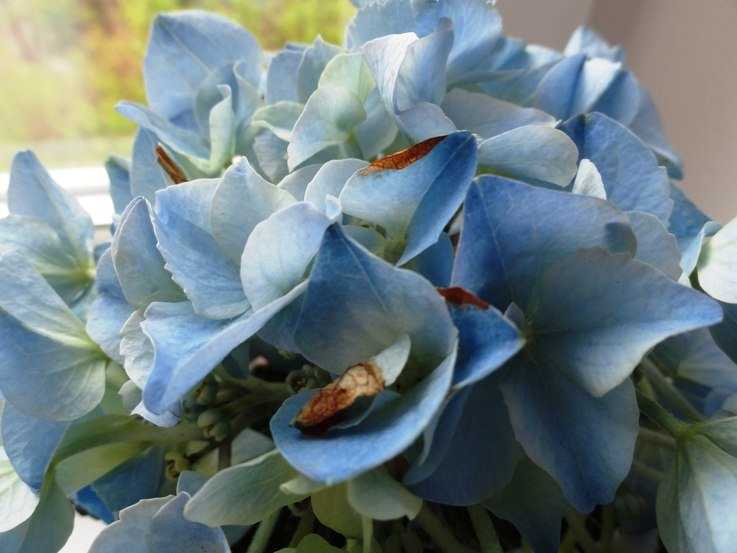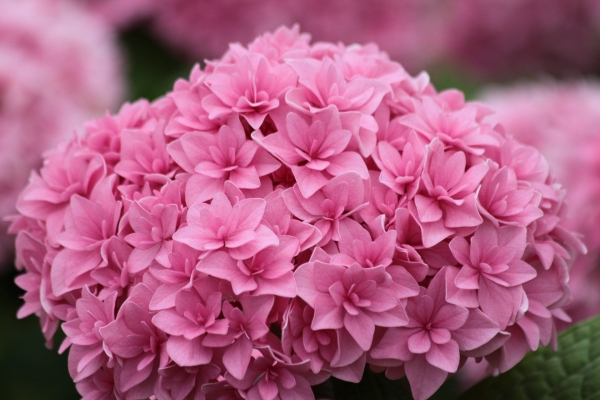Recommendations
When painting flowers in pink and blue tones, heed the advice of experienced florists.
-
Do not get carried away with the process of changing the color of flowers. The constantly changing level of soil acidity leads to a stressful state of the culture. If the gardener certainly wants to grow inflorescences of different shades on the site every year, it is recommended to plant several specimens at a certain distance from each other.
-
A change in the chemical composition of the earth to change the appearance of the petals must be carried out before the budding period. This usually occurs in early spring, when the culture is growing, but the inflorescences have not yet formed.
-
Regularly monitor the level of acidity of the soil in the flower bed and do not overdo it with these indicators.
-
Remember that only large-leaved varieties that tend to have color on the petals are capable of changing the color of the petals. Do not waste time, effort and nerves on other varieties, they still cannot be repainted.
-
Do not forget while experimenting that changing the color of the petals from pink to blue is much easier than vice versa.
-
Try not to overdo it when lowering the acidity of the soil to give the petals a pink "blush". In soils with high alkali levels, the plant may feel uncomfortable due to iron deficiency. As a result, the flower loses its aesthetic appearance, and sometimes it can shed inflorescences and leaves.
-
If the gardener wants to test flowers for their ability to stain, but other plants grow next to the culture that do not withstand acidic or alkaline soil, then it is recommended to plant the bushes participating in the experiment in separate large flowerpots. By experimenting with coloring in a separate container, the gardener does not have to worry about the health of neighboring crops.
-
The same applies to situations when you want to dilute a composition of pure blue flowers with pink inflorescences. You can build separate containers for staining, fill them with a substrate designed to contain pink hydrangeas, and grow flowers in isolation. In this case, individual specimens will receive a pink color.
How to water hydrangea to change color, see below.
General recommendations and important nuances
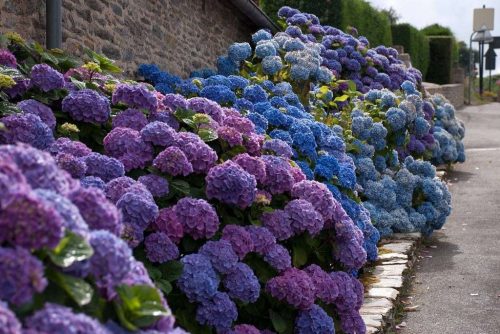
You should start feeding hydrangeas from the age of three.
Hydrangeas should be fed throughout the season (spring-autumn). But it is recommended to start carrying out the procedures not earlier than 2-3 years after planting the plants in open ground. Fertilizers need to be applied to a pre-moistened soil.
There is a general scheme for feeding hydrangeas, but there are some important nuances, namely the shade of the flowers and the appearance.
Influence of dressings on the shade of flowers
If desired, the shade of hydrangea flowers can be changed by making certain dressings. To get bluish flowers, you should additionally feed the pink species with a weak solution of ammonia alum at the rate of 4 g per 1 liter of water. In this case, the introduction of reddish peat into the soil will help to consolidate the obtained result.
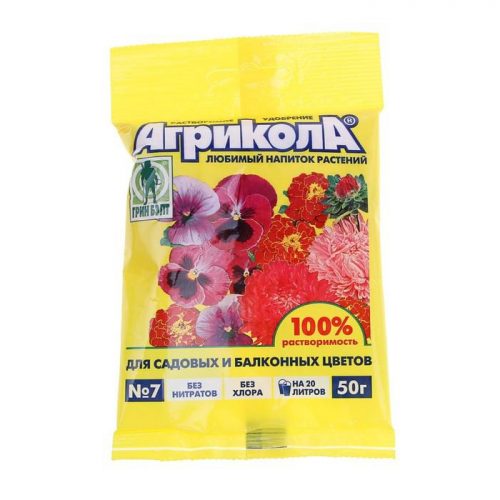
To obtain flowers of a rich pink hue, you should additionally feed the hydrangeas with Agricola for garden and balcony flowers.
In order for the pink inflorescences to become more saturated, they will need to be fertilized with potassium permanganate or Agricola for garden and balcony plants.
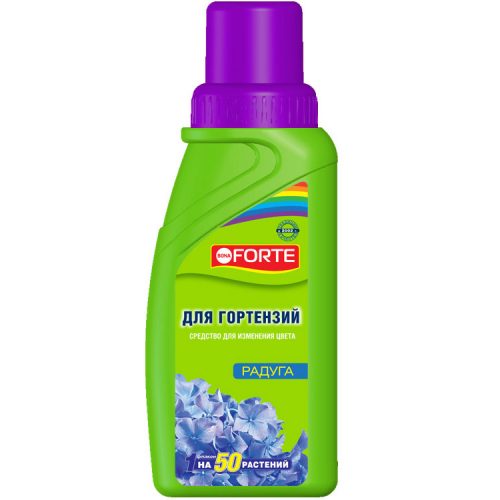
Bona Forte will help you to change the shade of flowers
In flower shops, a specialized color-changing agent Bona Forte is sold in the form of a liquid and a powder. This finished product is much easier to use to change the shade of hydrangea flowers.
Video: how to change the color of a hydrangea
Features of feeding different types of shrubs
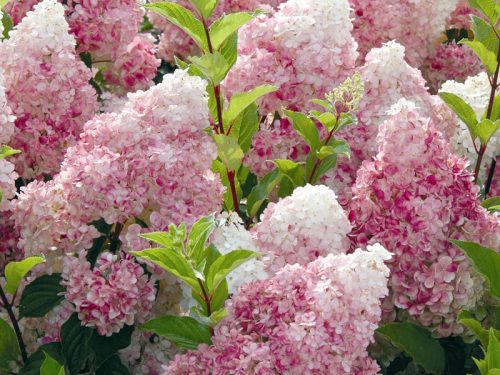
Spring feeding is most important for panicle hydrangeas
Each variety of this perennial shrub has certain characteristics that are recommended to be taken into account when feeding. For example, spring procedures are especially important for paniculate species. Such varieties respond well to organics. At the same time, dolomite flour is not suitable for them as a fertilizer.
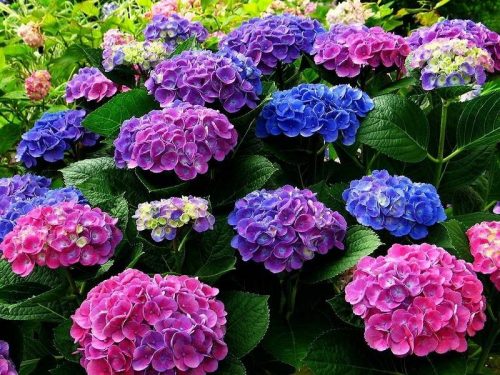
It is advisable to fertilize tree hydrangeas with manganese solution
Treelike hydrangeas are fed according to the general scheme. But in addition, it is recommended to fertilize them several times per season with a manganese solution so that the shoots are more flexible and hardy.
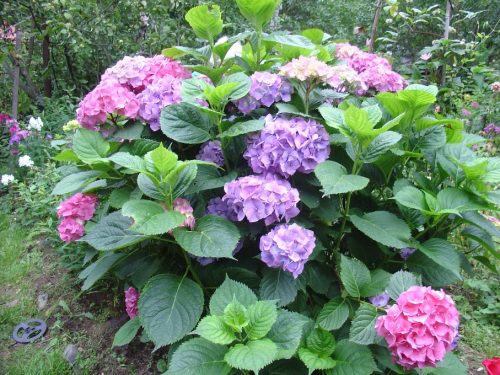
Large-leaved hydrangeas should be started to feed already in early spring.
Large-leaved hydrangeas require additional feeding at the beginning of the spring. As soon as the snow melts, it is recommended to fertilize the plants with a mixture of urea and potassium sulfate. Such feeding will help prepare shrubs for the growing season.
Soil acidity
In addition to the presence of aluminum in the earth, the changeable color depends on the acidity of the soil. For hydrangea to bloom blue, the pH must be below 5.5 pH. That is, the blue color causes acidic soil. If the pH level is 5.5-7 (the earth is neutral and slightly acidic), then the flowers will turn out to be light. If the pH is above 7 (alkaline earth), then the petals will appear pink.
Before you paint the hydrangea blue, you should determine the acidity of the soil.
How to determine acidity
- The popular method of determination is using ordinary chalk powder. It is not difficult to do it. You need to take 1 spoonful of garden soil. Mix it with 2.5 tablespoons of lukewarm water. Add half a teaspoon of chalk powder to the mixture. Mix everything and pour into a bottle with a narrow neck. Put a rubber fingertip on the bottle. There should be a minimum of air in the bottle. The mixture is shaken well and left for 15 minutes. If the fingertip is puffed up, it means that the soil in the area is sour. If air appears in it, but there is not much of it, then the soil is slightly acidic. If nothing happened, then the soil is neutral.
- Garden outlets sell special litmus tests. Together with them comes a colorful instruction. It indicates which color of the piece of paper corresponds to a certain type of soil. All new pieces of paper in neutral or yellow. They must be immersed in a mixture of water and earth. In this case, one spoonful of soil is taken, 4 tablespoons of water.
- The device. Such a device most accurately determines the pH value. But the device is not cheap either.
- Another simple way to determine acidity is by weed grass. It is known that the acidic earth is attractive for ferns, plantains, cornflowers, dandelions, chamomile, sedges. Nettle, thistle, shepherd's purse, quinoa are chosen as neutral ones. In the soil, the pH level of which is above 7, thyme, mustard, chicory, and spurge grow.
How to change acidity
Before changing the color of the hydrangea to blue, you need to make the soil acidic. The best pH is 4-5.4. If it drops less, it can negatively affect the culture.
Important! Aluminum is best absorbed by the plant if it is found in acidic soil. This is why a low pH is so important to get a new color.
Acidification work is carried out in the area next to the hydrangea bush. It is necessary to make an acidic soil layer of 30 cm.If planting is only planned, then the soil mixture intended for the planting pit is made acidic. You can make it sour with fresh sawdust, peat.
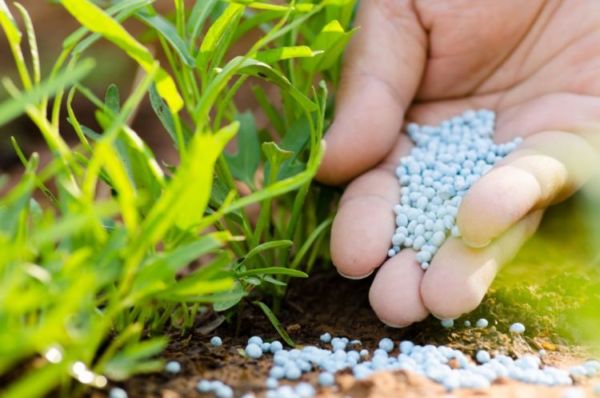
Acidify the soil for hydrangea
If acidification of the soil is required for an already planted plant, citric, acetic acid is used here. 2 tablespoons of citric acid are used in a 10-liter bucket of water. Vinegar 9% will be needed for the same volume of water 100 grams.Such procedures are organized several times per season, starting in early spring. Mulch in the form of needles, sawdust, high-moor peat, bark can help with oxidation.
Description and features of flowering
The botanical name for the shrub is Hydrangea, which means a vessel of water when translated from Greek. It immediately becomes clear that this plant is very fond of water. Many types of hydrangea are very thermophilic, therefore they can only grow in the southern regions. Only a few species of this plant are suitable for growing in regions of central Russia.
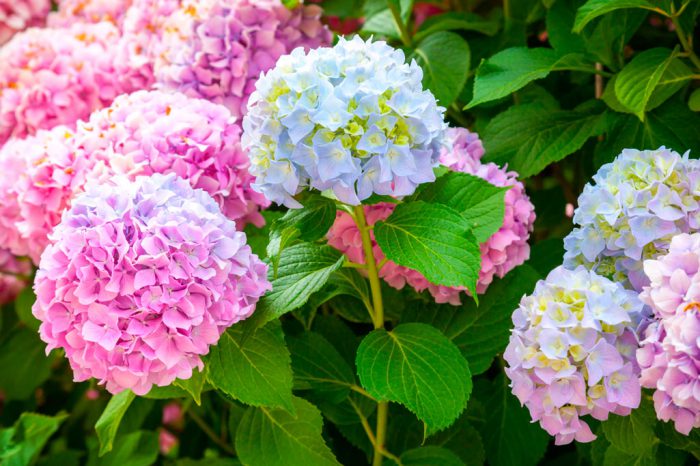
Hydrangea
This is a hydrangea:
- large-leaved (broadleaf);
- tree-like;
- paniculate;
- ground cover;
- petiolate.
The homeland of hydrangea is the East Asian countries (Japan and China). Later, the plant took root in South America and the Himalayas. The Japanese call hydrangea ajisai, which means a flower - a purple sun.
Important! Of the whole variety of types of hydrangea, as a home species, only garden or large-leaved hydrangea of compact sizes grows. Everyone else does not survive in indoor conditions.
Large-leaved hydrangea is native to China and Japan. It was cultivated in Europe since 1790, appeared in the Nikitsky Botanical Garden before 1840. It is a spreading, broad-leaved shrub that reaches 3.5 m in height, and in cold zones it grows up to 1.5 m. It grows very quickly.
Spherical crown up to 1.5 m in diameter. Stems are erect and slightly outstretched. The leaves are pointed, ovoid and about 20 cm long. The inflorescences are umbrella-shaped, reaching 15 cm. The color depends on the acidity of the soil. There are blue, lilac and pink hydrangeas of this species. It bears flowers from early July to late summer. Demanding on heat, soil moisture and sun.

Hydrangea paniculata
Treelike Hydrangia came from North America. It looks like a spectacular ornamental shrub, up to 2 m high. A spherical bush with thin branches. Leaves are oval, pointed, up to 20 cm long. The buds are large, with a diameter of up to 15 cm, in the form of a shield, with white 2 cm flowers. Blooms from mid-summer to October. Winter-hardy species with vigorous regrowth after very cold winters and active rooting of cuttings.
Paniculata Hydrangia - trees or shrubs that grow even up to 10 m. A species that came from East Asia. Elliptical 12 cm leaves. The buds are formed into pyramidal panicles, up to 25 cm long.
The first flowering occurs after 4-5 years, it is observed from the beginning of summer to October. High winter hardiness, unpretentiousness and decorative effect of long flowering are noted.
Hydrangea groundcover is native to the mountain forests of Northern China. Shrub, up to 3 m high, with a wide spherical crown. Brown shoots with 12 cm oval pointed leaves of dark green color.
Blooms white, towards the end of summer, purple umbellate inflorescences, up to 16 cm in diameter, which consist of half a thousand flowers. Blooms profusely in June-July.

Petiolate hydrangia
Is a liana-like shrub, which, with the help of suckers and aerial roots, rises along a support, up to 20 meters high. Often planted near a house, which she can completely entwine with her beauty. It spreads along the ground without support. The plant is native to East Asia. There are about 35 species, most often they are ornamental shrubs, sometimes they are observed in the form of a small tree. The leaves are long (up to 10 cm), pointed, smooth and shiny, dark green in color. The bare, reddish-brown shoots are equipped with aerial roots and suckers.
Flowers are found in white, pink or light purple hues. They form corymbose 20 cm inflorescences that cover the vine. Blooms from mid-June for two months. Pollinated by bees, an excellent honey plant.
Fertilization features
In the spring
If fertilized correctly, the flower will have a bright, beautiful leaf plate and abundant flowering throughout the season.
The first spring feeding is essential for healthy and strong leaves.It should be carried out in March, as soon as the sap flow begins. During this period, use:
- Nitrogen preparations. You can use a mixture of urea and potassium sulfate (20 g per bucket of water). For 1 bush, 5 liters of solution is enough.
- Organic matter, such as slurry.
- Phosphorus and Potassium. These minerals must be added before flowering. For 10 liters there is 1 tbsp. substances.
- Potassium permanganate. Spray the leaves of the bush with a weak solution (3 times in the spring). Then the plant will be strong and flexible.
Summer
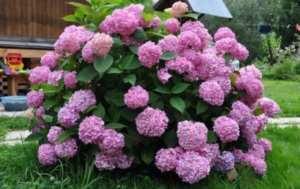
- In June, a solution of nitrophoska and Agricole is needed (20 g per bucket of water). Organic matter will not hurt either. Under each plant, you can pour 10 liters of diluted nettle infusion.
- In mid-July, the flower needs to be fed so that the inflorescences actively bloom and bloom for a long time. Purchased preparations are suitable, for example, Kemira flower. For 10 liters of water there is 1 tbsp.
- In August, you can use mineral fertilizers, alternating with organic ones.
In autumn
Autumn dressing is necessary to prepare the culture for the dormant period and the formation of young shoots with peduncles. Potassium-phosphorus compositions are used.
Potassium makes the plant's root system stronger and helps it survive the cold winter.
With the onset of autumn, the plant needs organic matter, for example:
- peat;
- compost;
- humus.
Spread the fertilizer near the bush in a layer of 5-10 cm. Then the soil will not freeze in winter, and the root system will be protected.

